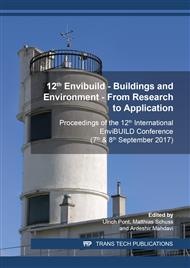[1]
A. Makarieva et al., Where do winds come from? A new theory on how water vapor condensation influences atmospheric pressure and dynamic, Atmos. Chem. Phys. 13 1039-1056.
DOI: 10.5194/acp-13-1039-2013
Google Scholar
[2]
M. Bielek et al., Aerodynamika budov (In Slovak), Alfa, Bratislava, (1990).
Google Scholar
[3]
T. Stathopoulos, Environmental Wind Engineering and Design of Wind Energy Structure, in: C. C. Baniotopoulos et al. (eds.), Environmental Wind Engineering and Design of Wind Energy Structures, CISM, Udine, 2011, pp.3-30.
DOI: 10.1007/978-3-7091-0953-3
Google Scholar
[4]
T. Lawson, Building aerodynamics, Imperial College Press, London, (2001).
Google Scholar
[5]
P. Juras, J. Zilinsky, Metodika merania vodotesnosti okien.(In Slovak) Almanach znalca : pre znalcov v odbore stavebnictvo, 3 (2012) 29-32.
Google Scholar
[6]
O. Hubova, P. Lobotka, The Natural Wind Simulations in the BLWT STU Wind Tunnel, Proceedings of ATF 3rd Conference on Building Physics and Applied Technology in Architecture and Building Structures (2014), 78-84.
Google Scholar
[7]
B. Blocken, 50 years of Computational Wind Engineering: Past, present and future, J. Wind Eng. Ind. Aerod. 129 (2014) 69-102.
DOI: 10.1016/j.jweia.2014.03.008
Google Scholar
[8]
J. Franke et al., The Cost 732 Best Practice Guideline for CFD Simulation of Flows in the Urban Environment: A Summary. Int. J. Environ. Pollut. 44 (2011).
DOI: 10.1504/ijep.2011.038443
Google Scholar
[9]
Ch. P. W. Geurts, Wind-induced pressure fluctuations on the building Facades, TU Universiteit Eindhoven, (1997).
Google Scholar
[10]
W. A. Dalgliesh, Comparison of model/full-scale wind pressures on a high-rise building, J. Ind. Aerodynam. 1 (1975).
Google Scholar
[11]
D. Staffenova et al., Climate Data Processing for Needs of Energy Analysis. Advanced Materials Research: enviBUILD, 1041 (2014) 129-134.
Google Scholar
[12]
Juras, P. et al.: Initial results of monitoring the temperature on the facade of office building. submitted to enviBuild (2017).
Google Scholar
[13]
OpenFOAM software Information on http://www.openfoam.org.
Google Scholar


